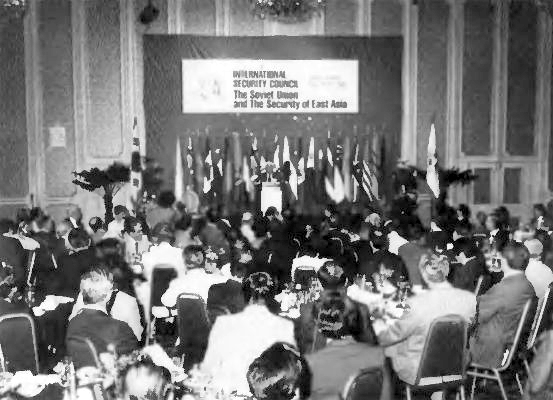![]()
The Words of the Osmond Family
|
|
The Words of the Osmond Family |

Based on material supplied by Hyo Hyun Park
One hundred fifty retired generals and military experts from 21 countries met in May in Seoul, Korea, for the Second International Security Council Conference. The ISC brings together military experts from all parts of the free world to discuss areas of strategic importance. Sponsored by CAUSA International, the conference had as its theme, "The Soviet Union and the Security of East Asia."
The meeting was most appropriate, since the Soviet Union has been conducting a massive military buildup in the Pacific for over 15 years. The Soviets have transformed what was once a small defensive coastal force into a vast navy with a decided emphasis on offense. With key military bases on the Sea of Okhotsk and the Sea of Japan, and now in Cam Rahn Bay in Vietnam, the Soviets are seeking to gain control of the sea lanes, particularly those between Vladivostok and Da Nang. These developments have caused increasing alarm among Asian nations, because this growth in Soviet prowess has taken place while the United States Pacific Fleet has been allowed to languish. Also dangerous to the safety of the region is the growing opposition to President Ferdinand Marcos, which has put the future of Clark Air Base in the Philippines in jeopardy.
At the plenary session of the ISC conference, Dr. Bo Hi Pak, the president of CAUSA International, welcomed the participants with a special address. Conference co-chairmen Admiral George G. Kinnear, USN (Ret), and General Osamu Namatame, JASDF (Ret), each gave a speech on the implications of the Soviet buildup in East Asia. Additional talks were given by General Saiyud Kerphal, RTA (Ret), and Major General John Cleland, USA (Ret), on the implications of the Soviet-Vietnamese alliance on the security of Southeast Asia.
In three working group sessions, papers were presented, followed by discussion. Afterwards, group rapporteurs summarized for all participants the insights and recommendations gleaned from their sessions.
Working group one, chaired by Rear Admiral James W. Nance, USN (Ret), discussed the Soviet grand strategy in Asia. Papers in the group strongly emphasized the tremendous Soviet military expansion in the Pacific. According to rapporteur Dr. Arnold Beichman, the group concluded that no combination of Asian countries can offset Soviet regional power without the direct military and economic aid of the United States. An important question is, therefore, how supportive the American public would be of an increased American presence in the Pacific. The group also highlighted South Korea and Japan as areas of concern, because the Soviets are currently demanding a military base in North Korea. As this would pose a direct military threat to South Korea, the United States must remain committed to that nation in the future.
The second working group, chaired by Ambassador William Kintner of the United States, discussed the Soviet strategic threat in Northeast Asia. Rapporteur Peter Samuel said the group discussed the Soviet use of military might, political struggle, propaganda, misinformation, and other manipulations of the free media to weaken open societies and bend them in a direction advantageous to the Soviet Union. The Soviets prefer to gain their political objectives without actual war with the major powers. However, they are not above making a dramatic show of military strength to intimidate the free world.
The group expressed concern that the Soviets may grow so frustrated with their inability to translate military advantage into political power that they may be tempted to "make some country an example" to show that their threats are not hollow rhetoric. Therefore, Samuel concluded, while political resistance to Soviet pressure is necessary, it is no substitute for adequate defense and military deterrence.
The third working group, chaired by General Saiyud Kerphal of Thailand, discussed the ramifications of the Soviet-Vietnamese alliance on the security of Southeast Asia and the Southwest Pacific basin. According to the chairman's report, "Because of the burden of military expenditures, the Vietnamese need Soviet economic assistance, which now involves $4-$6 million daily. That the Soviet Union is prepared to underwrite this kind of investment indicates the importance of the region in Moscow's global strategy." The group concluded that while each of the free nations in this region has its particular interests, the general threat, especially from the Soviet Union, should prompt cooperation among these countries. It was suggested that this should take the form of regular collective consultations, and possibly joint military exercises.
At the conclusion of the conference, a banquet was held at the Little Angels Performing Arts Center. The next day participants visited the DMZ, where they saw Panmunjom Truce Village and one of the infiltration tunnels built by the North Koreans. All were surprised at the very tense atmosphere at the border, where one million heavily armed troops are squared off only one hour's drive from the prospering capital city of Seoul. As a result of this visit, participants felt they understood the situation of Korea much better. One commented that indeed Korea is "the training field for learning about communism and its results."
The next day participants returned to their countries, after having gained more insight into the status of East Asia. Recommendations from this conference will be printed and distributed to agencies throughout the free world that influence the making of public policy.